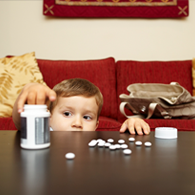Electrical goods
What are electrical goods?
Electrical goods, appliances or equipment are powered by electricity and are used in households to perform a range of everyday tasks, such as boiling a kettle or blow drying your hair.
How are children injured?
Electric shock and electrocution are the most common causes of injury or death to children associated with electrical goods. Damaged, faulty or misused electrical goods are the most common causes of electric shock or electrocution. Children can receive an electric shock or be electrocuted if they bite on power cords or cord plugs, place objects such as scissors or keys into power points or use appliances while in water.
Burns
Electric shock can result in burns to both the skin and internal tissues. In some cases, this can result in death by electrocution.
Cardiac and/or respiratory arrest
Children can suffer cardiac and/or respiratory arrest if they receive an electric shock from a faulty electrical appliance.
Muscle, nerve and tissue damage
Children can experience muscle, nerve and tissue damage after receiving an electric shock.
How common are these injuries?
A study in Australia showed that electrical injuries in children and older people were much less frequent than in other age groups. There were 79 cases of electrical injury in 0–14 year olds between July 2014 and June 2016.
In NSW, between 2014 and 2018, 25 children up to 16 years of age were treated in NSW hospitals for an electrical burn. Of these 44% were aged less than 5 years. 2
What are the laws, regulations or standards?
In NSW all electrical goods sold must meet the requirements of the Gas and Electricity (Consumer Safety) Act 2017(NSW) and the Gas and Electricity (Consumer Safety) Regulation 2018. This legislation covers the distribution of safe electrical appliances and other electrical goods which must be tested and approved before they can be sold. The easiest way to determine if an electrical good is approved is to see if it displays an acceptable approval mark, as shown on the NSW Fair Trading website.
Remember:
Fair Trading NSW recommends five simple rules for electrical safety.
Regular maintenance
- Electrical appliances should be checked regularly for any damage. Be aware of flickering indicator lights, smoke, hot fuses and noises such as popping, fizzing, spluttering, or erratic stop-start running.
- Never try to fix a faulty appliance yourself. Have it checked by a licensed electrical contractor. Always use a licensed electrician to do any electrical work.
- Second hand electrical appliances should be thoroughly checked for safety by a registered electrical contractor, licensed electrician or reputable appliance repairer, before use.
Certificate of compliance
- Your electrician should give you a ‘Certificate of Compliance Electrical Work’ to show the work has been tested and checked to ensure it complies with the regulations.
- Purchase electrical appliances that meet the Gas and Electricity (Consumer Safety) Act 2017 (NSW) and the Gas and Electricity (Consumer Safety) Regulation 2018.
Safety switches
- Have a safety switch installed by a licensed electrician. A safety switch saves lives by shutting off power when a faulty appliances or bad wiring is detected.
Contact your landlord or agent
- If you’re renting, report electrical problems to your landlord or agent immediately. They should be repaired as a priority.
Report electrical accidents
- If you receive medical treatment for an electrical injury, by law it must be reported to your electricity provider or NSW Fair Trading on 13 32 20.
The Children’s Hospital at Westmead also recommends the following.
Water and electricity
- Teach children never to touch electrical switches with wet hands and to be careful when using electrical appliances near water. Never use an appliance that has had water spilt on it. If an appliance causes a tingling sensation while you’re using it, switch it off at the power point and have it checked.
- Never pour water on an electrical fire. Only use a fire extinguisher designed for electrical fires or a fire blanket.
- Do not leave appliances such as hair dryers and portable heaters in the bathroom (children have been electrocuted by pulling hair dryers into baths even though the hair dryer was switched off).
- Do not use electric blankets on children’s beds, especially if they are still in nappies or wet the bed.
Power points and power boards
- Always switch off electrical appliances at the power point and unplug after use.
- Unplug appliances by pulling the plug rather than the cord.
- Make sure switches and power points are in good condition. They should not be cracked, broken or loose. Unused power points should be covered with safety plugs to prevent small children and infants from placing objects or fingers into sockets.
- When using power boards, only use boards with an overload cut out switch. Appliances that heat up, such as toasters and kettles, draw more power. Running too many of these types of appliances from a standard power point could overheat power boards, creating a potential fire danger.
- Always be aware of how much current the appliances you plug into a power point draw. Care should be taken not to "piggy-back" double adaptors or stack plugs on top of each other as this may overload the power point and cause a fire.
Electrical cords
- Always replace frayed cords or damaged plugs, and unwind extension cords fully so they don’t overheat.
- Never place electrical cords or extension leads under rugs or carpets. Pressure from people and equipment moving over cords can cause heat build-up and result in a fire.
- Keep electrical cords out of reach of children. Make sure cords do not dangle over bench tops or trail on the floor.
- Don’t allow children to fly kites or model aeroplanes anywhere near overhead wires.
Check for products that have been recalled (Product Safety | Recalls) before buying or borrowing an item for use with your child.
References
1 Australian Institute of Health and Welfare (2018). Electrical Injury: Hospitalizations and Death ISSN 2205-510X (PDF), INJCAT 197.
2 NSW Statewide Burn Injury Service. Unpublished data. August 2019







